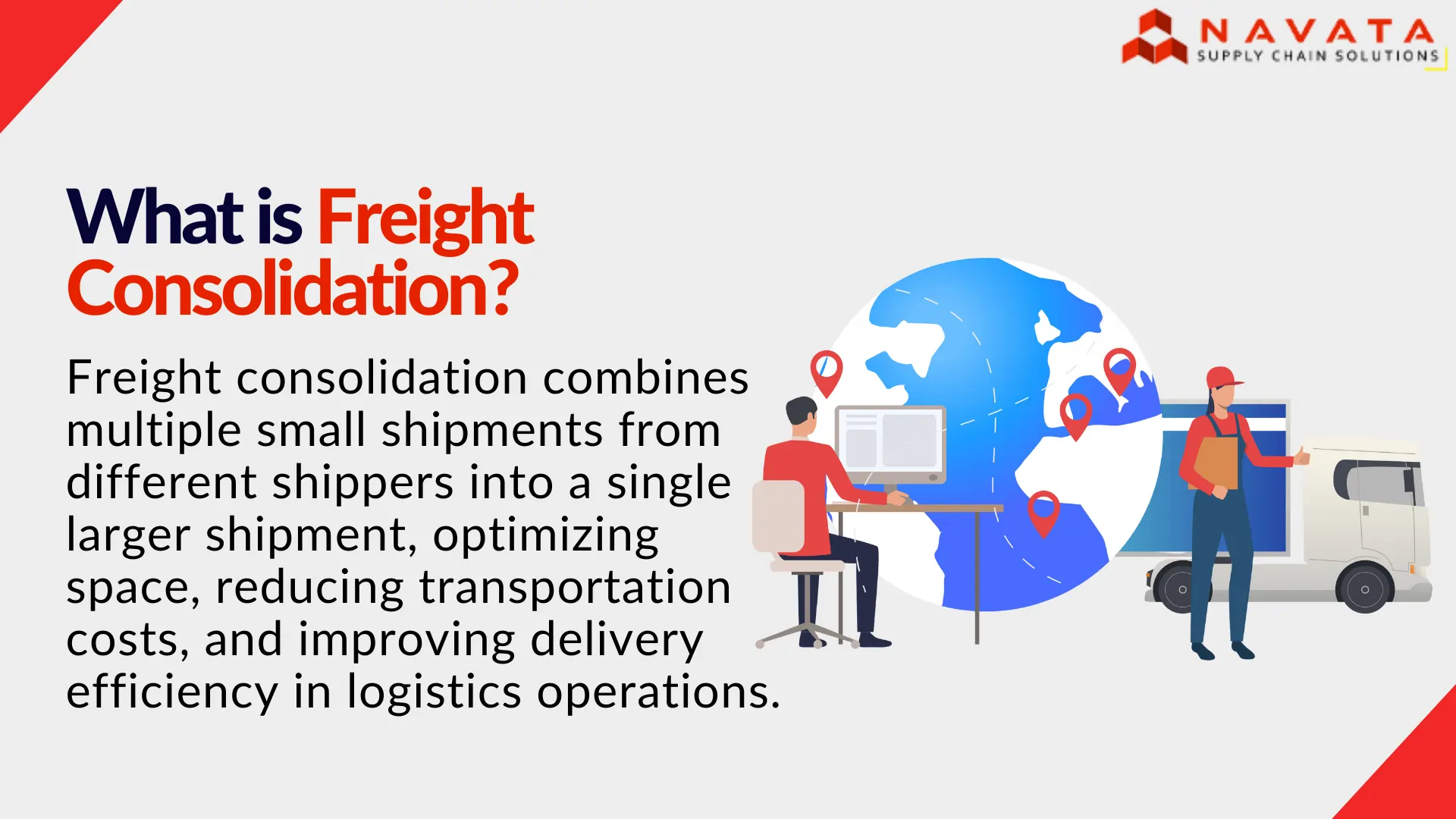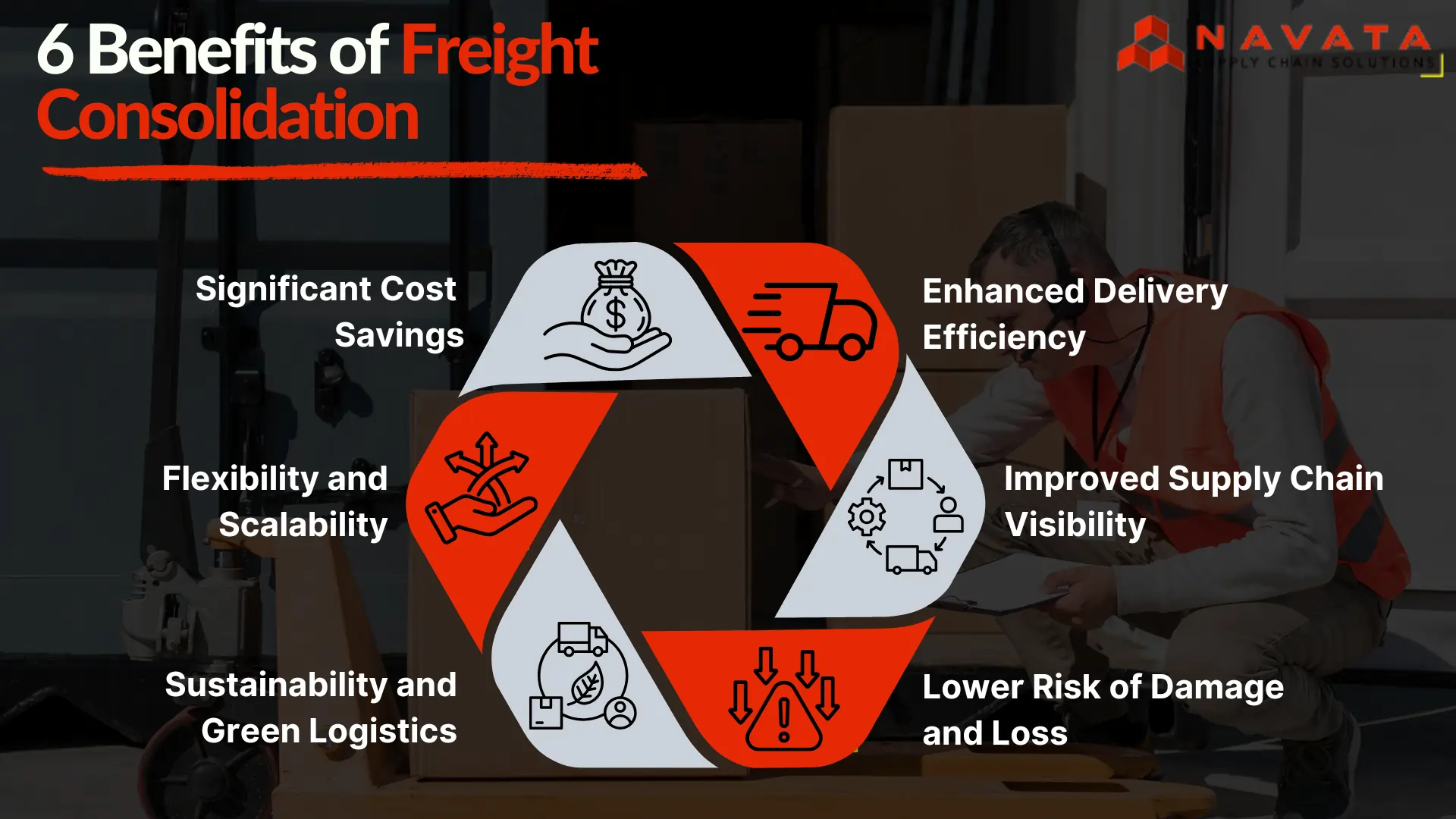What is Freight Consolidation?
Freight consolidation stands as a cornerstone strategy for reducing costs and improving transportation efficiency. At its core, freight consolidation refers to the practice of combining multiple smaller shipments from different shippers or origins into a single, larger load that moves as a full truckload (FTL) or container.
This approach maximizes space utilization, minimizes transportation costs, and streamlines delivery operations. Unlike traditional shipping methods that move partial loads independently, freight consolidation focuses on collaboration, coordination, and optimization — making it a critical component of modern logistics management.

How Freight Consolidation Works
Freight consolidation typically begins at a consolidation warehouse or logistics hub, where multiple less-than-truckload (LTL) shipments are gathered, categorized, and combined based on destination, cargo type, and delivery schedule.
Once consolidated, the goods are loaded efficiently into a single transport unit — truck, container, or railcar — and dispatched to a deconsolidation facility or final delivery points. Advanced logistics technologies such as Transportation Management Systems (TMS), Warehouse Management Systems (WMS), and route optimization software ensure seamless execution, providing real-time visibility and tracking across the supply chain.
Types of Freight Consolidation
Freight consolidation can take several forms depending on the logistics strategy, shipment origin, and destination. Understanding the different types helps businesses choose the most efficient model, optimize transportation costs, and improve supply chain performance.
Buyer’s Consolidation: Combines shipments from multiple suppliers for a single buyer — ideal for importers managing several vendors.
Supplier Consolidation: Merges goods from one supplier destined for multiple buyers, streamlining outbound shipments.
Third-Party (3PL) Consolidation: Managed by logistics providers who consolidate loads across multiple clients for maximum efficiency.
Hub-and-Spoke Consolidation: Uses central hubs to collect, merge, and redistribute shipments efficiently across large geographies.
Key Benefits of Freight Consolidation
1. Significant Cost Savings
Freight consolidation reduces transportation costs by combining multiple smaller shipments into a single full truckload (FTL), which is significantly cheaper than sending each shipment individually as less-than-truckload (LTL). By optimizing routes and minimizing empty miles, businesses can lower fuel consumption, reduce labor costs, and improve vehicle utilization
Result: Lower per-unit shipping costs and improved logistics ROI.
2. Enhanced Delivery Efficiency
Consolidated freight allows logistics providers to streamline routes, reduce vehicle trips, and coordinate shipments more effectively. This not only shortens delivery times but also reduces congestion at distribution hubs.
Result: Faster, more reliable deliveries across regions.
3. Improved Supply Chain Visibility
Modern freight consolidation leverages digital tools like Transportation Management Systems (TMS), Internet of Things (IoT) sensors, and real-time tracking. This provides full visibility of shipments from origin to destination. Businesses can monitor delays, track inventory levels, and proactively manage exceptions.
Result: Smarter decision-making and stronger supply chain resilience.
4. Lower Risk of Damage and Loss
Handling multiple small shipments separately increases the chances of damage, misplacement, or theft. Consolidation minimizes handling points by moving goods in fewer shipments, ensuring better control and care.
Result: Fewer claims and better customer trust.
5. Sustainability and Green Logistics
Freight consolidation contributes to eco-friendly supply chain practices. Fewer trips and optimized load planning reduce fuel consumption and carbon emissions. Many companies combine consolidation with electric fleets or hybrid vehicles to further lower environmental impact.
Result: Greener operations aligning with global sustainability goals.
6. Flexibility and Scalability
Freight consolidation allows businesses to scale operations dynamically during peak seasons or fluctuating demand. Consolidation hubs and distribution centers enable seamless adjustments to shipment volumes without disrupting existing operations.
Result: Seamless adaptability for eCommerce, retail, and manufacturing sectors.

Challenges in Freight Consolidation
While freight consolidation offers significant benefits, it also comes with operational challenges that businesses must manage carefully. Recognizing these obstacles and addressing them proactively ensures smooth and efficient logistics operations.
Common Challenges:
Coordination Complexity: Managing multiple shippers and schedules can be difficult without advanced TMS.
Extended Lead Times: Consolidation sometimes delays departures while waiting for other shipments.
Space Allocation Conflicts: Predicting available space in shared transport can be tricky.
How to Overcome Them:
Digital logistics platforms, predictive analytics, and real-time visibility tools can eliminate inefficiencies and ensure optimal load management, keeping operations efficient and reliable.
When is Freight Consolidation Most Effective?
Freight consolidation works best in specific operational contexts where combining shipments adds measurable value. Understanding these scenarios helps businesses maximize efficiency, reduce costs, and improve delivery performance.
Multiple smaller orders: When several smaller shipments are going to similar destinations, consolidation reduces costs and handling.
Regional or cross-border operations: Ideal for businesses shipping across multiple locations or countries, optimizing transport networks.
Peak seasons or eCommerce demand: Helps manage high-volume periods without overloading logistics resources.
Balancing cost, speed, and sustainability: Consolidation ensures efficiency while supporting faster delivery and greener operations.

Conclusion
Freight consolidation is more than a cost-saving tactic — it’s a strategic enabler of efficiency, sustainability, and supply chain control. By intelligently merging shipments, businesses reduce waste, improve visibility, and enhance operational performance.
Today fast-paced global trade, organizations leveraging consolidated freight strategies gain a lasting advantage in speed, reliability, and cost management.
Thanks For Reading: What is Freight Consolidation? Working, Types & Benefits
Powered By 360Presence

